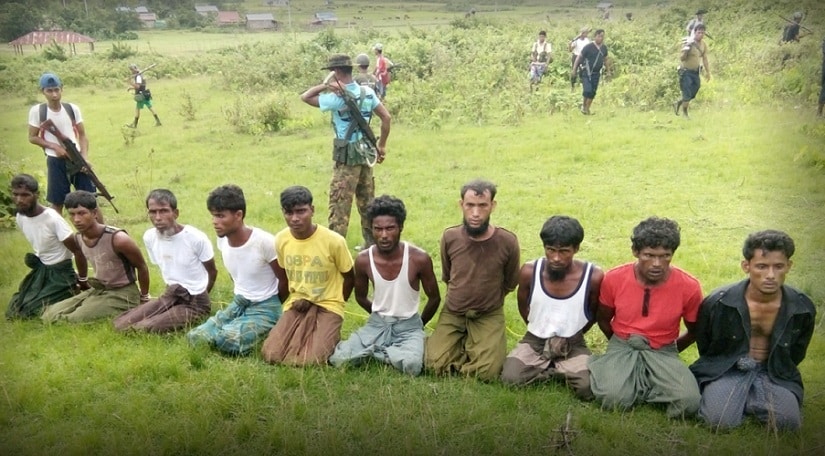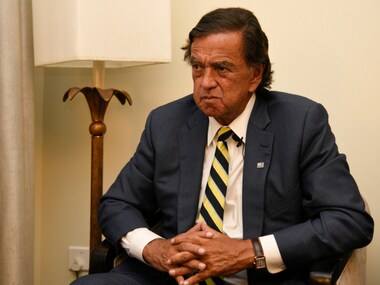Bound together, the 10 Rohingya Muslim captives watched their Buddhist neighbors dig a shallow grave. Soon afterwards, on the morning of 2 September, all 10 lay dead. At least two were hacked to death by Buddhist villagers. The rest were shot by Myanmar troops, two of the gravediggers said.
"One grave for 10 people," said Soe Chay, 55, a retired soldier from Inn Din's Rakhine Buddhist community who said he helped dig the pit and saw the killings. The soldiers shot each man two or three times, he said. "When they were being buried, some were still making noises. Others were already dead."
The killings in the coastal village of Inn Din marked another bloody episode in the ethnic violence sweeping northern Rakhine state, on Myanmar's western fringe. Nearly 690,000 Rohingya Muslims have fled their villages and crossed the border into Bangladesh since August. None of Inn Din's 6,000 Rohingya remained in the village as of October.
The Rohingya accuse the army of arson, rapes and killings aimed at rubbing them out of existence in this mainly Buddhist nation of 53 million. The United Nations has said the army may have committed genocide; the United States has called the action ethnic cleansing. Myanmar says its "clearance operation" is a legitimate response to attacks by Rohingya insurgents.
Rohingya trace their presence in Rakhine back centuries. But most Burmese consider them to be unwanted immigrants from Bangladesh; the army refers to the Rohingya as "Bengalis". In recent years, sectarian tensions have risen and the government has confined more than 100,000 Rohingya in camps where they have limited access to food, medicine and education.
Reuters has pieced together what happened in Inn Din in the days leading up to the killing of the 10 Rohingya — eight men and two high school students in their late teens.
Until now, accounts of the violence against the Rohingya in Rakhine state have been provided only by its victims. The Reuters reconstruction draws for the first time on interviews with Buddhist villagers who confessed to torching Rohingya homes, burying bodies and killing Muslims.
This account also marks the first time soldiers and paramilitary police have been implicated by testimony from security personnel themselves. Members of the paramilitary police gave Reuters insider descriptions of the operation to drive out the Rohingya from Inn Din, confirming that the military played the lead role in the campaign.
The slain men's families, now sheltering in Bangladesh refugee camps, identified the victims through photographs shown to them by Reuters. The dead men were fishermen, shopkeepers, the two teenage students and an Islamic teacher.
Three photographs, provided to Reuters by a Buddhist village elder, capture key moments in the massacre at Inn Din, from the Rohingya men's detention by soldiers in the early evening of 1 September to their execution shortly after 10 am on 2 September. Two photos — one taken the first day, the other on the day of the killings — show the 10 captives lined up in a row, kneeling. The final photograph shows the men's bloodied bodies piled in the shallow grave.
The Reuters investigation of the Inn Din massacre was what prompted Myanmar police authorities to arrest two of the news agency’s reporters. The reporters, Burmese citizens Wa Lone and Kyaw Soe Oo, were detained on 12 December for allegedly obtaining confidential documents relating to Rakhine.
Then, on 10 January, the military issued a statement that confirmed portions of what Wa Lone, Kyaw Soe Oo and their colleagues were preparing to report, acknowledging that 10 Rohingya men were massacred in the village. It confirmed that Buddhist villagers attacked some of the men with swords and soldiers shot the others dead.
The statement coincided with an application to the court by prosecutors to charge Wa Lone and Kyaw Soe Oo under Myanmar's Official Secrets Act, which dates back to the time of colonial British rule. The charges carry a maximum 14-year prison sentence.
But the military's version of events is contradicted in important respects by accounts given to Reuters by Rakhine Buddhist and Rohingya Muslim witnesses. The military said the 10 men belonged to a group of 200 "terrorists" that attacked security forces. Soldiers decided to kill the men, the army said, because intense fighting in the area made it impossible to transfer them to police custody. The army said it would take action against those involved.
Buddhist villagers interviewed for this article reported no attack by a large number of insurgents on security forces in Inn Din. And Rohingya witnesses told Reuters that soldiers plucked the 10 from among hundreds of men, women and children who had sought safety on a nearby beach.
Scores of interviews with Rakhine Buddhist villagers, soldiers, paramilitary police, Rohingya Muslims and local administrators further revealed:
• The military and paramilitary police organised Buddhist residents of Inn Din and at least two other villages to torch Rohingya homes, more than a dozen Buddhist villagers said. Eleven Buddhist villagers said Buddhists committed acts of violence, including killings. The government and army have repeatedly blamed Rohingya insurgents for burning villages and homes.
• An order to "clear" Inn Din's Rohingya hamlets was passed down the command chain from the military, said three paramilitary police officers speaking on condition of anonymity and a fourth police officer at an intelligence unit in the regional capital Sittwe. Security forces wore civilian clothes to avoid detection during raids, one of the paramilitary police officers said.
• Some members of the paramilitary police looted Rohingya property, including cows and motorcycles, in order to sell it, according to village administrator Maung Thein Chay and one of the paramilitary police officers.
• Operations in Inn Din were led by the army's 33rd Light Infantry Division, supported by the paramilitary 8th Security Police Battalion, according to four police officers, all of them members of the battalion.
Michael G. Karnavas, a US lawyer based in The Hague who has worked on cases at international criminal tribunals, said evidence that the military had organised Buddhist civilians to commit violence against Rohingya "would be the closest thing to a smoking gun in establishing not just intent, but even specific genocidal intent, since the attacks seem designed to destroy the Rohingya or at least a significant part of them".
Evidence of the execution of men in government custody also could be used to build a case of crimes against humanity against military commanders, Karnavas said, if it could be shown that it was part of a "widespread or systematic" campaign targeting the Rohingya population. Kevin Jon Heller, a University of London law professor who served as a legal associate for convicted war criminal and former Bosnian Serb leader Radovan Karadzic, said an order to clear villages by military command was "unequivocally the crime against humanity of forcible transfer".
In December, the US imposed sanctions on the army officer who had been in charge of Western Command troops in Rakhine, Major General Maung Maung Soe. So far, however, Myanmar has not faced international sanctions over the violence. Myanmar's leader Aung San Suu Kyi has disappointed many former supporters in the West by not speaking out against the army's actions. They had hoped the election of her National League for Democracy party in 2015 would bring democratic reform and an opening of the country. Instead, critics say, Suu Kyi is in thrall to the generals who freed her from house arrest in 2010.
Asked about the evidence Reuters has uncovered about the massacre, government spokesman Zaw Htay said, "We are not denying the allegations about violations of human rights. And we are not giving blanket denials."
If there was "strong and reliable primary evidence" of abuses, the government would investigate, he said. "And then if we found the evidence is true and the violations are there, we will take the necessary action according to our existing law."
When told that paramilitary police officers had said they received orders to "clear" Inn Din's Rohingya hamlets, he replied, "We have to verify. We have to ask the Ministry of Home Affairs and Myanmar police forces."
Asked about the allegations of looting by paramilitary police officers, he said the police would investigate.
He expressed surprise when told that Buddhist villagers had confessed to burning Rohingya homes, then added, "We recognise that many, many different allegations are there, but we need to verify who did it. It is very difficult in the current situation."
Zaw Htay defended the military operation in Rakhine. "The international community needs to understand who did the first terrorist attacks. If that kind of terrorist attack took place in European countries, in the US, in London, New York, Washington, what would the media say?" he asked.
Published Date: Feb 09, 2018 12:04 PM | Updated Date: Feb 09, 2018 12:04 PM





















